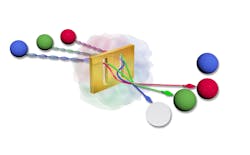New light sources may power next-generation quantum technologies
Next-generation quantum technology, devices, and phenomena are poised to advance further and possibly quicker with the help of a nanoscale system that could create light.
Led by Louisiana State University (LSU) and its Experimental Quantum Photonics Group (Baton Rouge, LA; part of LSU’s Department of Physics and Astronomy), an international team of researchers has demonstrated the potential of metallic nanostructures to produce various forms of light. The team has also shown that optical near-fields provide more scattering paths that can induce complex multiparticle interactions.
According to the study, the team has observed modified quantum states—for the past two decades, scientists have observed the plasmon-assisted transmission of entangled photons, which later “gave birth to the field of quantum plasmonics.”1 The coupling of single photons to collective charge oscillations at the interfaces between metals and dielectrics has led to the generation of single surface plasmons. Their recent findings, the researchers note, have unveiled the possibility of exciting surface plasmons with quantum mechanical properties.
In their work, the team has also shown that the quantum statistics of multiparticle systems are not always preserved in their plasmonic platforms. Their discovery essentially changes “a paradigm in quantum plasmonics.”
“Our findings unveil the possibility of using multiparticle scattering to perform exquisite control of quantum plasmonic systems,” says LSU postdoctoral researcher Chenglong You, a lead author of the study. “This result redirects an old paradigm in the field of quantum plasmonics where the fundamental physics uncovered in our discovery will provide a better understanding of the quantum properties of plasmonic systems and unveil new paths to perform control of quantum multiparticle systems.”
Important discoveries
Previously, scientists thought the quantum properties of bosons—a subatomic particle that has zero or integral spin and follows the statistical description given by S. N. Bose and Einstein—are preserved in plasmonic systems, and therefore will not create a different form of light.
Today, researchers are focusing on light’s quantum properties as well as its interaction with matter at a nanoscale level. As discussed in the study, the team is now working to preserve “non-classical correlations in light-matter interactions mediated by scattering of photons and plasmons,” after assuming that “similar dynamics underlie the conservation of the quantum fluctuations that define the nature of light sources.”
The researchers in this study were able to show that optical near-fields provide additional scattering paths that can induce complex multiparticle interactions (see figure).
“We engineered metallic nanostructures, fabricated in gold, to produce different kinds of light,” says LSU graduate student Mingyuan Hong, who co-led the study. “Our nanoscale platform exploits dissipative plasmonic near-fields to induce and control complex interactions in many-body systems of photons. This capability allows us to control at will the quantum fluctuations of multiphoton systems.”
Engineering light with various quantum mechanical properties could ultimately enhance and advance multiple quantum technologies.
“For example, our platform enables the reduction of the quantum fluctuations of multiphoton systems to boost the sensitivity of protocols for quantum sensing,” says Assistant Professor Omar Magaña-Loaiza, who participated in the study. “In our lab, we will exploit this exquisite degree of control to develop quantum simulations of light transport. This will enable the eventual design of better and more efficient solar cells.”
REFERENCE
1. C. You et al., Nat. Commun., 12, 5161 (2021); doi:10.1038/s41467-021-25489-4.
About the Author
Justine Murphy
Multimedia Director, Digital Infrastructure
Justine Murphy is the multimedia director for Endeavor Business Media's Digital Infrastructure Group. She is a multiple award-winning writer and editor with more 20 years of experience in newspaper publishing as well as public relations, marketing, and communications. For nearly 10 years, she has covered all facets of the optics and photonics industry as an editor, writer, web news anchor, and podcast host for an internationally reaching magazine publishing company. Her work has earned accolades from the New England Press Association as well as the SIIA/Jesse H. Neal Awards. She received a B.A. from the Massachusetts College of Liberal Arts.

